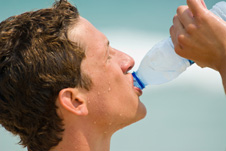WeekendWatch: Tips for keepin’ it cool

You’ll probably want to lounge around in your air-conditioned home this weekend, when temperatures are expected to hit triple digits. But if you dare venture outside, Sabrina E. Noel and Esther Carver who work in the Department of Health Sciences in Northeastern’s Bouvé College of Health Sciences, offer tips for staying cool.
What are the signs that someone has been out in the heat for too long?
There are at least three signs, including heat cramps, heat exhaustion and heat stroke.
-Heat cramps are painful muscular cramps and spasms that are caused by loss of fluids and are brought on by strenuous activity in high heat. These are often an early sign that the body is having trouble with the heat. If you are suffering from heat cramps, then move to a cooler place, rest, and drink small amounts of fluids every 15 minutes.
-Heat exhaustion typically involves the loss of body fluids through heavy sweating during strenuous exercise or physical labor in high heat. Symptoms include cool, moist, pale or flushed skin; heavy sweating; headache; nausea; dizziness; weakness; and exhaustion. Move to a cooler place, drink small amounts of cool water and watch for changes in your condition.
-Heat stroke — also known as sunstroke — is a life-threatening condition in which a person’s temperature control system stops working and the body is unable to cool itself. Signs of heat stroke include hot, red skin which may be dry or moist; changes in consciousness; vomiting; and high body temperature. Move the person to a cooler area and call 911 immediately. Immerse them in or spray them with cold water, if possible, until help arrives.
What are some tips to keep your body temperature regulated?
Stay hydrated by drinking plenty of fluids, even if you do not feel thirsty. Early signs of dehydration are thirst, flushed skin, fatigue, increased body temperature, faster breathing and pulse rate, followed by dizziness, increased weakness and labored breathing with exercise. If you must be outdoors, start hydrating several hours before beginning your activities and try to schedule outdoor activities in the morning or evening, when it is cooler. Take frequent breaks if you must work outdoors.
Wear loose-fitting, lightweight, light-colored clothing and avoid dark colors that absorb the sun’s heat. You should also avoid hot, enclosed places, such as cars. Never leave children or pets unattended in a car parked in the sun.
What foods are the best to eat when the weather is hot, and why?
Eat solid foods that supply a good amount of water like lettuce, watermelon, oranges, grapefruits and yogurt. Avoid alcoholic and sugar-sweetened beverages, which can dehydrate your body.
Pay careful attention to food safety in the heat by keeping cold foods below 40 degrees and hot foods above 140 degrees. Don’t let perishables, such as meat, fish, poultry and dairy foods sit out for more than one hour.





